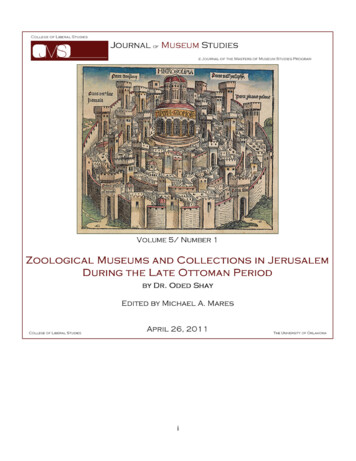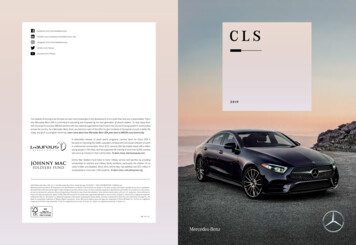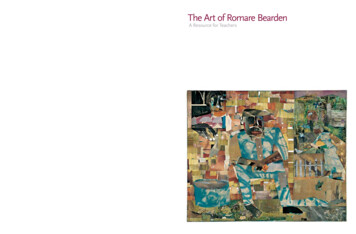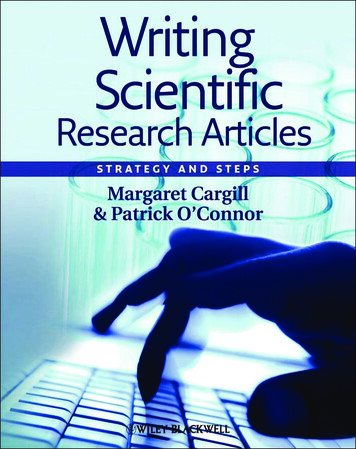
Transcription
i
CLS Journal of Museum Studies, Volume 5, Number 1CLS Journal of Museum Studies, Vol. 5, No. 1. (2011)URL: http://www.ou.edu/cls/jms/CLS Journal of Museum Studies is currently published online by theCollege of Liberal Studies, MALS Museum Studies Program, theUniversity of Oklahoma.Your use of the CLS Journal of Museum Studies archives indicatesyour acceptance of the Terms and Conditions of Use, available athttp://jms.ou.edu/. Museum professionals, students, and otherreaders are encouraged to distribute the articles published in thisjournal as widely as possible, to use them in classes, and to reprintthem as needed. For commercial use of any of these articles(e.g., charging for articles, republishing figures, tables, text, etc.),permission must be obtained from the Editor. All questions relatingto the journal should be directed to the Editor.Publisher contact information may be obtained athttp://jms.ou.edu/Each copy of any part of a CLS Journal of Museum Studiestransmission must contain the same copyright notice that appearson the screen or PDF file of such transmission.CLS Journal of Museum Studies is an independent not-for-profitpublication dedicated to creating and preserving a digital archive ofscholarly articles in the field of museum studies. For moreinformation regarding CLS Journal of Museum studies, pleasecontact Dr. Michael Mares at mamares@ou.eduhttp://jms.ou.edu/Publication date: April 26, 2011i
CLS Journal of Museum Studies, Volume 5, Number 1CLS JOURNAL OF MUSEUM STUDIESVolume 5, Number 1/2011The CLS Journal of Museum Studies is issued annually (withindividual numbers appearing as they are completed) by the Collegeof Liberal Studies, MALS Museum Studies Program of theUniversity of Oklahoma. The CLS Journal of Museum Studies isdesigned to provide a worldwide e-journal as a publication outlet forstudents enrolled in the Museum Studies Program of the College ofLiberal Studies of the University of Oklahoma. The journal is alsodesigned for use by faculty in the CLS MALS program. Any topic ofrelevance to the field of museum studies is considered suitable forpublication in the journal.Contributions may be solicited by the Editor from museumprofessionals not affiliated with the MALS Museum StudiesProgram. All submissions are reviewed by one or more members ofthe Editorial Board or by outside reviewers.COVER ILLUSTRATION: Jerusalem, 1493 woodcut. NurembergChronicles.ii
CLS Journal of Museum Studies, Volume 5, Number 1Journal EditorDr. Michael A. Mares, Director, Sam Noble Oklahoma Museumof Natural History, and Joseph Brandt Professor, Department ofZoology, University of OklahomaEditorial BoardGail Kana Anderson, Assistant Director/Curator of Collections,Fred Jones Jr. Museum of Art, University of OklahomaMarcia Britton, Executive Director, Wyoming Council for theHumanities, Laramie, WyomingByron Price, Director, University of Oklahoma Press and CharlesM. Russell Center for the Study of Art of the American West,University of OklahomaPeter Tirrell, Associate Director, Sam Noble Oklahoma Museum ofNatural History, University of OklahomaDr. Mary Jo Watson, Director and Regents’ Professor, School ofArt and Art History, University of Oklahomaiii
CLS Journal of Museum Studies, Volume 5, Number 1CLS Journal of Museum Studies, Vol. 5, No. 1. (2011)The CLS Journal of Museum Studies is published annually by theCollege of Liberal Studies, MALS Museum Studies Program, theUniversity of OklahomaDr. Michael A. Mares, Journal EditorManuscripts submitted for the Journal and all correspondenceconcerning them should be addressed to Dr. Michael A Mares.Guidelines for contributors are given on the last page of this volume.Copyright 2011 by the College of Liberal Studies, University ofOklahomaLaid out by Catherine Kerley, on a format established by Dr.Michael A. Mares.iv
CLS Journal of Museum Studies, Volume 5, Number 1CLS Journal of Museum Studies, Vol. 5, No. 1. (2011)ContentsForeword: Natural History Museum Buildersby Michael A. MaresZoological Museums and Collections in JerusalemDuring the Late Ottoman Period, by Dr. Oded Shayvvii1
CLS Journal of Museum Studies, Volume 5, Number 1Foreword:Natural History MuseumBuildersMichael A. MaresSam Noble Museum, University of Oklahoma, Norman, Oklahoma 73072According to Albert Bickmore, the young museum builder who had fought fora place for a new museum in New York City, the proposed museum site wasactually “most desolate and forbidding. There was a high hill at the northeast corner.and in the north west corner another hill of solid rock rose muchhigher than the elevated railroad station.In the southern and central part ofthe square, just where the first section of our building was to be erected, was athird hill, whose crest rose as high as the ceiling of our present Hall of Birds.As I sat on top of this rock, the surrounding view was dreary and my onlycompanions were scores of goats.” (The City Review)Albert Bickmore’s comments in 1864 referred to the futurebuilding site in Central Park that he had struggled to obtain inorder to realize his dream of a great natural history museum forthe City of New York. I am certain that such gloomycomments echo strongly with most museum builders who have undertakenthe difficult task of planning, developing, and building a natural historymuseum. New museums are never easy to build, and more than a fewmuseum projects have long histories of directors who failed in the attemptto dream, plan, raise interest in, identify funding for, and finally build themuseum. Each phase can take a long time to complete. And whereas artmuseums seem to pop up almost like banks, natural history museums—with their massive collections, research, and exhibit needs—are large,difficult institutions to plan, build, and staff (e.g., there are more artmuseums in New York State than there are natural history museums in theentire United States). So natural history museum builders are oftenunusually tenacious personalities willing to risk it all to get the job done.1
Foreword: Natural History Museum Builders, MaresFig. 1. Bust of Albert Bickmore in American Museum of Natural HistoryOther examples of museum builders who struggled to realize theirdreams abound. In the Kansas Legislature of 1899 (nearly a half centuryafter Bickmore’s travails) in regards to a bill to fund a new natural historymuseum for the University of Kansas (Sharp and Sullivan, 1990:131),“A Jefferson County representative stated that he did notwish to go home and tell his constituents that the state couldnot provide a suitable place for its destitute insane, but couldspend 65,000 ‘for a building to cover [Lewis Lindsay]Dyche’s dead animals.’ Buck Dawes, Republican floor leader,also attacked the proposed amendment, declaring, ‘It’s ashame that the professors come up here from that school andneglect their work to lobby for these buildings. We have givenenough to that institution already.’”Fig. 2 Lewis Dyche, builder of the University of Kansas natural historymuseum.The next year, as Dyche [the first director and museum builder ofthe University of Kansas Museum of Natural History] had to go toTopeka to meet with the legislature and seek funds for a new building,Sharp and Sullivan (1990:142-143) noted:2
CLS Journal of Museum Studies, Volume 5, Number 1“Lobbying for a museum building in 1890, Dychearticulated his dream to Regent Charles F. Scott. ‘I want tosay that while I am not as old as some people yet I am mucholder than I used to be. I have done my best for years to buildup a good collection of large mammals, and while doing sohave gone up against some pretty heard propositions. I wantto do one thing more. I want to put the collections I havemade in the best possible shape to insure their futurepreservation. This done I am ready to quit and ‘go a fishing’all the rest of the days of my life.’”The two quotations relating to the development of the Universityof Kansas Museum at the turn of the 19th Century point out a similartheme. Dyche was tired of the fighting required to get support to build amuseum, whether from city, state, or local governments, or private donors.The search for the great amount of money required to found a museumcan be staggeringly exhausting. No wonder he wanted to “go a fishing”! Iam also a museum builder, having been primarily responsible for a largenew facility for the Oklahoma Museum of Natural History (today the SamNoble Museum) on the University of Oklahoma campus in Norman,Oklahoma. In reviewing the story of the challenge of actually building thenew facility (as opposed to raising interest, funds, or developing a design), Iwrote: “ there were enormous challenges in getting the project completedmore or less on time and within budget The eternal struggle between thebuilder and architect took place, with me having final say on almostanything to do with the massive and complex structure. I knew that if Irelented in the quality of the final project, the impact would extend acrossthe generations” (M. A. Mares, 2002:48).As this quotation illustrates, even after a new museum project hasbeen sold to the powers that be, and after the site has been selected andfunding has been obtained, one still has to build the building, and this isalways an enormous challenge. My own chance to get away for a while wasto do field research in South America and, since I study small mammalsand am not a fisherman, I periodically “went a trapping!” I could definitelyidentify with Dyche.The men and women who have built natural history museumshave almost without exception had to meet and overcome enormouschallenges. Even some of the greatest museums in the world, such as theNatural History Museum in London, had to struggle in their earliest days.“There were also the political ramifications of Londonscience in the 1860s [to be considered], an immenselycomplex subject . In the many scientific debates, the shiftingof groups and alliances, one important matter recurred againand again, the extension of the British Museum. Should therebe new buildings to house the natural history collections or3
Foreword: Natural History Museum Builders, Maresshould these be removed to another site, and if so, which site?[Richard] Owen, of course, was Director of the naturalhistory collections. After the failure of his first attempt to getthe existing building extended, Owen decided as early as 1859that the natural history collections would have to move from[the British Museum at] Bloomsbury. This meant that he wason the lookout for a new site, which would indeed be aterritory dominated by Owen, and this resulted in a sort ofspatial dialectic with [Thomas Henry] Huxley [Owen’s bitterrival and one of England’s greatest zoologists]. From 1858onwards Huxley led a campaign against Owen's plans.However, in 1863 the parliamentary bill to buy the site waseventually carried and the principle of removing the naturalhistory collections to South Kensington decided. Throughthe 1860s plans moved slowly forward, with Cole's favouritelieutenant, Captain Fowke, winning the competition for thenew building in 1864. When Huxley did decide that he toohad to move to South Kensington, there were already veryhandsome plans afoot to build Owen his temple of naturalhistory” (Forgan and Gooday, 1996:444-445).Fig. 3. Sir Richard Owen, builder of the Natural History Museum inLondon.As the above makes clear, even giant personalities of history, suchas Sir Richard Owen and Sir Julian Huxley, did battle over the siteselection and plans to build one of the greatest museums in the world. Inpart, their feud was based on personality differences, as well as differencesin their views of evolution. But the great museum Owen built ended upbeing not only a cathedral to nature, but also a cathedral to evolution. Itremains today as one of the most impressive natural history museumbuildings in the world.4
CLS Journal of Museum Studies, Volume 5, Number 1Fig. 4. The Natural History Museum, London.(Photo by David Illif, Creative Commons)Even the great Spencer Baird, who was responsible for thedevelopment of the United States National Museum, wrote in 1853:“I expect the accumulation of a mass of matter thuscollected (which the Institution cannot or will not ‘curate’efficiently) to have the effect of forcing our government intoestablishing a National Museum. The coming session ofCongress is going to be a stirring one. I would not be muchsurprised to hear of attacks being made on the Smithsonianby persons dissatisfied with the administration of its funds.The great question of a National Museum will probably bebrought forward numerous plans are talked of. I don’tmuch care how they manage it, so that I can have charge ofthe Nat. Hist. collections.” (Rivinus and Youssef, 1992:154).Museum builders often began as scientific collectors. They werefield biologists, archeologists, paleontologists, or geologists. Life in the fieldcollecting specimens under all conditions and in locations around theworld can be extremely challenging (e.g., Mares 2002). Conducting thiskind of research leads a person to expect challenges, threats, difficulties,and other roadblocks to successful completion of the field research,challenges that must be overcome. Perhaps it is not surprising that so manymuseum builders came from the ranks of the field collectors. Not only didtheir research result in extensive collections, they, more than anyone else,realized the true value and irreplaceable nature of the collections and theextraordinary cost in blood, sweat, tears, and lives, that was required tobuild the collections in the first place. They recognized the need to find a5
Foreword: Natural History Museum Builders, Maressuitable home to protect these materials across time and to permit theirfull utilization by future generations.In my own case, my dream of a museum was a very large one forone of the poorest states in the nation (M. A. Mares, 2002:48):“I was under great pressure to build an inexpensiveprefabricated building. Why did I need so much money?Surely the 35 million that I was talking about was way toomuch museum for the university and for Oklahoma. Whycouldn’t I do it for 10 million? I replied with such questionsas, ‘What is Oklahoma’s heritage worth?’ I knew that thepeople of Oklahoma thought it was worth a lot. I myselfthought that it was priceless. ‘How can you put Oklahoma’sheritage in a cheap building?’ I asked. Plans came forth fromvarious administrators to make the project less expensive.Why not build an exhibits building and leave the collectionswhere they are—in the barns and stables? Why not build acheap storage facility and forget about exhibits? Why not getrid of the most of the collections and just build an inexpensivebuilding for displays?”The struggle to build Oklahoma’s natural history museumconsumed 17 years of my life. Not many directors are willing to dedicate25-30% of their life, and perhaps half of their working life, to building amuseum, much less dealing with a project that can be highly contentiousover much of that span of time.On a personal note, I believe that museum builders haveexceedingly strong personalities built from the adversity they haveexperienced in their lives and work. They are dreamers. They are articulateenough to be able to convince people to believe in the dream. They may berisk takers. Consider the fact that there may be no museum at all whenthey begin their quest, or the existing museum may be housed inextraordinarily poor facilities that have remained unchanged across thedecades. Change is hard, and change that is expensive is even more difficultfor people to accept. Reading about the history of many natural historymuseums, it does not seem to matter much whether museums were built acentury and half ago, 10 years ago, or even today. For example,Milwaukee’s Journal Sentinel on January 21, 2011, reported the following(Journal Sentinel, online): Milwaukee County should make way for anew, world-class Milwaukee Public Museum and additional development,according to Milwaukee businessman/philanthropist MichaelCudahy .You’ve got to create a fever, a movement in Milwaukee that sayswe are going to have the best public museum in the UnitedStates .Supervisor Gerry Broderick, chairman of the County Board’sparks committee said It seems to me the community has a number of6
CLS Journal of Museum Studies, Volume 5, Number 1other priorities that trump the idea of a new museum, like feeding thehungry and taking care of the mentally ill.”Remarkably, 111 years after Dyche’s efforts to obtain funding forthe new Kansas museum were pitted against the needs of the insane, theexact same argument was made in Milwaukee in opposition to a newmuseum for the city. The battles to develop a museum seem to be astimeless as the museums themselves. I would not be surprised to find thatthe earliest museum builders faced similar challenges.My comments about museum builders relate directly to the CLSJournal of Museum Studies’ first article on international museology andhistory by Dr. Oded Shay. Dr. Shay presents a fascinating review of thedevelopment of natural history museums in Palestine (and Israel) andshows that there were several larger than life personalities who wereresponsible for Israel’s collections of birds, mammals, and other organismsthat are in Israel’s natural history museums today. These collectorsincluded a member of royalty, a diplomat, and a pioneeringclergyman/naturalist. Notably, none of these early museum naturalists hada job that required them to collect specimens or explore for new flora andfauna. They did this with a willing passion for discovery, a love of nature,and a strong drive to make people aware of their environment. IsraelAharoni, one of the great naturalists of the Middle East, was thepreeminent museum builder of the region. I have no doubt that were healive today he could identify with those museum builders from allcountries who labored (and labor) against great odds to develop museumsthat bring an awareness of nature and natural history to generations ofpeople that are yet to be born.ReferencesCity Review, The. 2011. (Accessed 14 February 2011).Forgan, S. and G. Gooday. 1996. Constructing South Kensington: thebuildings and politics of T. H. Huxley's working environments. TheBritish Journal of the History of Science. 29:435-468.Journal Sentinel. 2011. tml(Accessed February 17, 2011).Mares, M. A. 2002. Miracle on the prairie. Museologia 2:31-50.Rivinus, E. F., and E. M. Youssef. 1992. Spencer Baird of the Smithsonian.Smithsonian Institution Press, Washington, D. C.7
Foreword: Natural History Museum Builders, MaresSharp, B., and P. Sullivan. 1990. The Dashing Kansan. Lewis LindsayDyche. The Amazing Adventures of a Nineteenth-Century Naturalist andExplorer. Harrow Books, Kansas City, Missouri.The south rotunda of the Sam Noble Museum, University ofOklahoma, Norman, Oklahoma8
The Monastery of the Flagellation, Jerusalem, site of one of theearliest natural history exhibits in Israel(Photos used with permission of Brian McMorrow)Zoological Museums andCollections in JerusalemDuring the Late OttomanPeriodDr. Oded ShayDepartment of Jewish History, Ben-Gurion University, Beer Sheva, IsraelThe establishment of zoological museums and collectionsworldwide and the manner in which these collections weredeveloped as part of the general development of art, history, andarcheology museums and collections. During the Renaissanceand the 16th and 17th centuries, a “new spirit” came about that reflectedintellectual curiosity. New continents and cultures were being discovered,revealing new horizons and hitherto unknown species of animals andplants. With time, artifacts and exhibits began to accumulate in privatecollections, in the salons and houses of the rich, including kings andprinces. The collections contained articles and exhibits derived from thenatural world. Other collections were the fruit of labors of doctors,pharmacists, and chemists employed in the service of royal households and1
Zoological Museums and Collections, Shaythe church. These collections contained minerals, medicinal herbs, andanimal hides.This period witnessed progress in the preservation of animals andthe development of new taxidermy methods. Development of these newtechniques preceded the process of collection and preservation of bird andanimal specimens. At the same time, a gallery in the Medici palace inFlorence opened to the public for the first time with an exhibition ofartistic creations side by side with animal specimens, shells, fossils,minerals, and other artifacts from the natural world (Scherer, 1913, 6-42).With the opening of private collections to the public in Europe in the 18thcentury, a process began whereby “general” exhibitions were replaced bysingle-discipline exhibitions. Exhibitions covering nature not onlydisplayed animal specimens and rare artifacts but also represented theliving flora and fauna in the widest sense.Abstract. The first zoological collections were concentrated at monasteriesand churches in Jerusalem and included the Dalman bird exhibit at theLutheran church school in Moristan, the Schmitz specimens exhibited atthe St. Paulus Hostel, and the natural history collection exhibited at theFranciscan Museum in the Monastery of the Flagellation. At the sametime, the Bezalel Museum was established in Jerusalem, initially containinga natural history collection set up by Aharoni. The museum later featuredart, Judaica, and archeology. Selah Merrill was an important privatecollector. Activities of the natural history explorers Aharoni, Merrill, andSchmitz, were motivated by a combination of national and religious fervorthat accompanied their zoological studies and exploration of Palestine.The common denominator to all three was the intimate anduncompromising link to the Bible. The aim of the collections was firstly torevive the living world of the Bible and origins of ancient times. They alsorecognized a need to collect zoological specimens to preserve the zoologicalhistory of the country in light of the accelerated development ofsettlements and agriculture and consequent impact on the naturalenvironment. The collection of animal hides was varied. Most collectorsstuffed the hides, while others bought them from hunters and employedtaxidermists. Zoological collections were established following theaccelerated development of Palestine at the beginning of the 20th centuryand had economic significance: animal hides were sold to various overseasmuseums, providing substantial incomes for Aharoni, Merrill, andSchmitz. Moreover, butterfly collections provided samples for carpetsproduced in the workshops of Bezalel.Establishing zoological museums and collectionsInitially, the collections were almost completely lacking in scientificinterpretation. This all changed when Carl von Linné laid the foundationsfor the method of classification of plants and animals. These scientific2
CLS Journal of Museum Studies, Volume 5, Number 1collections, based on private collections, were the basis for theestablishment of natural history museums in Europe. Natural historymuseums in Paris and London were established at the close of the 18thcentury. Thereafter, natural history museums were established throughoutEurope and in the USA based upon private collections of wealthycollectors and pioneering researchers. In the 19th century, museumsprovided research opportunities for geologists, paleontologists, botanists,zoologists, anthropologists, and other scientists. Museums were popularwith the public, which found great pleasure in observing the universalwonders of the natural world (Alexander, 1989, 10, 41; Meyer, 1911, 2931). An additional stage in the development of natural history museumsbegan in the USA in 1890 with the advent of the diorama.At the end of the 19th century, the notion of “extinction” becameprevalent among the scientific community following the revelation ofnumerous life forms that no longer existed on the planet. Observations ofextinction relied on the tales of travelers and seafarers about creatures thatexisted in this or that location but were no longer present. It became clearto zoologists that natural history collections in museums were the lastremaining places to observe the remains of extinct creatures. The need topreserve organisms for future generations became the overriding mission ofthe museum, and this new approach heralded the institutionalization ofthe museum in its modern sense.In contrast to Europe and the USA, the development of museumsand zoological collections in Palestine was different. Indeed, scientificdiscoveries and research in Palestine in the 19th century were similar toresearch in many other unexplored territories around the world. In theearly 19th century, living forms were more or less unknown andunresearched. Western Europeans had not explored most areas in Palestine(Goren, 2003; Ben-Arieh, 1983). The majority of explorers of the east ingeneral, and Palestine in particular, were American, English, German, andFrench. Most were in the service of exploration societies. One explorer ofthe Jewish lands at the beginning of the 19th century, even before theresearch societies appeared, was Rabbi Joseph Schwarz (1804-1865), whoresided in Jerusalem. Within the framework of his studies of the history ofthe land, he examined the fields of nature and biology. His interest wasdriven by an attempt to understand different aspects of Jewish origins.Animal research stemmed from his desire to identify animals referred to inthe bible.3
Zoological Museums and Collections, ShayFig. 1. Walter Rothschild arriving at Buckingham Palace with a team ofzebras.Schwarz was in continuous communication with the Munich BiologicalMuseum and its research staff and was a visitor on a number of occasions.He carried out measurements and tests on specific animals. For example,he identified the barn owl and wrote: “and already I have sent this verminas exemplary proof to the West to the King’s museum in München inBayern State, so that proof of the genuine article can be seen andacknowledged” (Schwarz, 1900).Another Jewish non-resident of Palestine, Walter Lionel Rothschild(1868-1937), a renowned ornithologist, owned collections of preservedspecimens of birds of Palestine. He established a private museum at hisestate in Tring, near London, that contained mainly preserved specimensof birds and butterflies (Aharoni, 68, 87, 193).Fig. 2. Henry Tristram, early ornithologist.4
CLS Journal of Museum Studies, Volume 5, Number 1A pioneer of natural sciences of Palestine was the clergyman andBritish ornithologist Henry Baker Tristram, who visited Palestine onnumerous occasions in the second half of the 19th century. He was one ofthe founders of the “Fund for Research in Palestine” and earned the title of“father of zoology of Palestine.” He published many books and papers, thebest known being his book on the flora and fauna of Palestine (1889). Hetook a special interest in birds, building a collection numbering 20,000specimens from all parts of the world, which he sold to the LiverpoolMuseum at the end of the 19th century. Animal specimens collected duringhis sojourn in Palestine were transferred to the Natural History Museumin South Kensington in London, and dried plants were given to the BotanyMuseum in Cambridge (Tristram,1866; ibid., 1894).During the 19th century, a number of German researchers arrived inPalestine and engaged in the collection and transfer of specimens toGermany. One of these researchers was Gotthilf Heinrich von Schubert(1780-1860), the curator of zoological collections in München. He visitedPalestine in 1836-1837, during which time hides of many rare animalswere collected and transferred to Germany. Likewise, Dr. Rudolph Roth(Wagner, 1859), curator of zoology at the Munich museum, visitedPalestine during the first half of the 19th century and collected animal hidesand plants. Ernst Gustav Schulz (1811-1851) was appointed as Prussianconsul in Jerusalem in 1842. He hunted wild animals and collected florafrom the Jerusalem area for transfer to Germany (Wolff, 1857, 208).Another tourist, the heir to the Austrian throne, Prince Rudolph (18581889), was an ornithology enthusiast and keen hunter of wildfowl duringhis visit to Palestine (Prince Rudolph, 1884). In the 19th century, thecollection of animal hides was considered a zoologist’s highest priority.Today, hide and study specimen collections gathered and defined over theyears and supplemented with DNA sequence data provide the basis for allzoological work, including animal classification, identification, andphylogeny.Palestine’s first Hebrew zoological museumIsrael Aharoni (Aharonovitz) was born in 1880 in the town of Viczi,near Vilna in Lithuania. His father, Abraham-Joseph was a rabbi, principalof the local yeshiva and author of “The Scattered Sons of Israel.” Aharoniwas orphaned at an early age and reared in his grandparents’ household.His grandmother influenced his life and nurtured his love for animals. Shetold him stories of animals and even brought him birds that that had beencaught in the synagogue (Aharoni, 1943, 19, 7). When Aharoni was agedseven, he contracted diphtheria and was bedridden for a lengthy period.Friends of the family brought him a sparrow, which was a source of greatwonderment. Later on, he studied in the Telshe Yeshiva and, in additionto torah studies, read many other books. He took particular pleasure inShalom Yaakov Abramovitch’s book, known by its nickname “Mendele5
Zoological Museums and Collections, Shaymoocher sefarim,” “The History of Nature,” which in effect is a translation,in three volumes, of “The History of Nature” in German by Lenz from1863. Abramovitch wrote his book in the language of the bible and gavethe animals Hebrew n
the University of Kansas Museum of Natural History] had to go to Topeka to meet with the legislature and seek funds for a new building, Sharp and Sullivan (1990:142 -143) noted: CLS Journal of Museum










